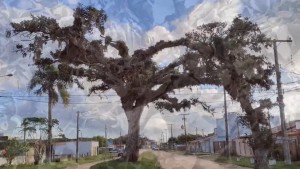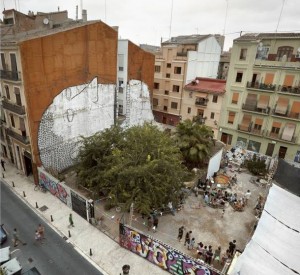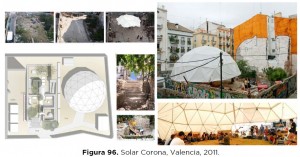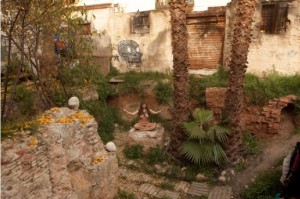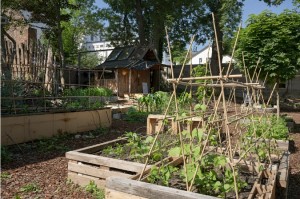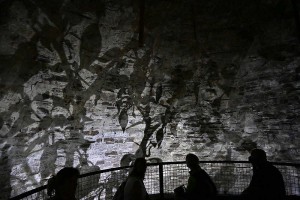Although normally, when there is a video projection ―in this case “The tree, the forest and the 2-Headed Snake”, within the multimedia installation “Ecology: the necessary evil”, by Janice Martins Appel and Domingo Mestre―, it is offered after the exhibition in the room through the web, this time we are going to anticipate, because there are some aspects that it is convenient for the public to know beforehand, because they relate all the works on display.
Image of “The tree, the forest and the 2-Headed Snake”, by Domingo Mestre.
The video “The tree, the forest and the 2-Headed Snake”, a production by Domingo Mestre, with music by Vickyleaks ―in its exhibition in the room to access the audio you have to do it through a QR code and listen to it on your mobile; here on the web it can be seen and heard on the screen above―, it is made up of a selection of photographs of trees ―a kind of slideshow―, which have been taken in the south of the metropolitan area of Porto Alegre, on the beach do Cassino, Rio Grande, and in the municipality of Pelotas (all in the Federated State of Rio Grande do Sul, Brazil). Superimposed on these images is the movement of wandering through a field covered with dry persimmon leaves, recorded in the proximities of Alginet, Valencia, Spain. It is, therefore, the places of residence of Janice Martins Appel and Domingo Mestre, that now, like the 2-Headed Snake, intertwine and intermingle.
The selection of the images of the trees responds to the general tone that inspires the entire installation, which fixes its attention on the interrelation of human activity with the environment, which is giving rise to a growing entropy. But in this case, attention is focused not only on the interference that human activity causes in the natural environment, but also on the presence and energy, despite everything, of nature in the urbanized environment.
Domingo’s interest in the presence of nature in the urbanized environment comes from far. Before the meeting with Janice Martins Appel at Corona Plot and the formation of the Serpiente de 2 Cabezas group in 2015, Domingo had already been operating in this field, closely related to working with collectives. Working with collectives is of paramount importance in relation to obtaining this type of result. Although Narcís Selles, in that review of his artistic biography which is the Prologue to Domingo’s book: art, culture and imposture, although he refers to this topic of working with collectives very briefly ―it can be assumed that he does not delve further into this issue by the dates in which it is written and published (2008), a historical moment in which the habit of paying attention almost exclusively to individual artistic activity was still dragging on. But today, with the perspective that the passage of time gives us, we have no doubts about the relevance of collectively developed social and artistic experiences, such as, for example, the Corona Plot ―in which Domingo participated in a very active way―. This is so, especially after Documenta 15 (Kassel, 2022), collectives and the work developed by collectives became the protagonists of this macro exhibition.
From the perspective that the passage of time gives us, what can be observed in the experience of Corona Plot is that there was a collective realization project, which had the objective of creating a public space, certainly closely related to the development of activities cultural and artistic by the groups that had it as their “headquarters”, but also open to the general public, because an important part of it was a garden.
The Corona Plot with its magnificent garden among the ruins of the foundations of an old textile dye factory.
In addition, a garden with very peculiar characteristics, because there was a part that was created by the users, as an orchard-garden, but there was another part that was pre-existing, made up of the vegetation that had grown spontaneously among the ruins of the foundations of an old textile dye factory. In addition, a garden made up of species from here and there, probably as a result of being a site located in a highly anthropized urban environment, so it should not be surprising that the pollination of species present on balconies and terraces, acquired by its inhabitants in nearby nurseries where, for common gardening purposes, you can find species from almost anywhere on the planet, preferably those known as exotic species, highly valued by a certain type of conventional gardening. In short, that the Corona Plot garden was an entropic garden.
A lot has been written about the Corona Plot experience (2011-2018). Among others, the thesis by Ester Giménez: “The subjective city in contemporary Valencia”, 2015 (the same architect who created the La Posta space), which collects images and plans, particularly from an initial moment driven by the Comboi a la fresca collective, and the installation of the geodesic dome that was used for various meetings.
What is being proposed now with “The tree, the forest and the 2-Headed Snake” is in a certain line of continuity with what was that experience of Corona Plot and its entropic garden. In the sense of the importance given to the garden as a place of materialization of cultural traces that arise from the life of groups that have little or nothing to do with the established frames of reference.
Janice Martins Appel, “Ser Jardim” [Be Garden], Corona Plot, Valencia, 2015. Photo: Domingo Mestre.
We have previously referred to the importance of the latest edition of Documenta (15), Kassel 2022, in recognition of the work carried out by collectives dedicated to cultural and artistic activities, which also act with a strong involvement in the immediate sphere, collectives from all over the planet (because it has also been the most internationalist Documenta), some of them have also presented gardens, among which we have to refer to the work of the Nhà Sàn Collective, from Vietnam, and the artist, also Vietnamese, Nguyen Trinh Thi.
Nhà Sàn Collective, Tuan Mami, “Vietnamese Immigrating Garden”, en el WH22, Documenta 15, Kassel 2022.
As regards the Nhà Sàn Collective, they presented at WH22 [Werner-Hilpert-Strasse 22], as the main piece, the “Vietnamese Immigrating Garden”, by Tuan Mami, who is also the promoter of the collective, and in the purpose-built woodshed, Quynh Dong’s video projection, “Poem Garden” (2022), and Phu Luc (The Appendix Group) painted ceramics, “I-Ching Hexagram #59”, 2022.
At Documenta there has always been a latent concern for ecological issues, but this time it has gone further, since willow seeds and wild plants have been planted, and all of this has been conceived as a social practice. The place chosen for the sample of the work, in an abandoned space inside a group of buildings, promoting its reuse, also confronts the viewer with a post-industrial and post-commercial environment (it is a residual space of an old wine shop).
Nguyen Trinh Thi, Landscape series #5: And They Die a Natural Death, 2022. Light, shadows, chilli plants, live transmited wind, automated flutes. In the Rondell, Documenta 15, Kassel 2022.
Regarding the work of Nguyen Trinh Thi, usually dedicated to film and video art, for Documenta 15 she has presented an installation (certainly very cinematographic), in the Rondell, next to the Walter-Lübcke-Brücke that crosses the Fulda, an old defensive tower that inside it also served as a torture chamber. A very appropriate space for the staging of one of the chapters of the autobiographical book Tale Told in the Year 2000 by Bùi Ngọc Tấn, in which he describes life in the detention camps in northern Vietnam from the 1960s to that of 1970. The writer details the flora and fauna of the forests: ecosystems that became places where he and other prisoners were forced to perform forced labor. At the Rondell in Kassel, Nguyen relocates that scene from the book by presenting a sculptural installation of clusters of chili plants that, when illuminated, cast an enveloping shadowy forest on the surrounding walls. A system driven by the wind and transmitted by wi-fi, installed in the Vinh Quang-Tam Da area of Vietnam activates the Kassel installation of ventilators, audiovisual effects, sound, and the haunting playing of the sáo ôi flute, an indigenous musical instrument used by groups in the northern mountains where the Mường, Tày and Nùng ethnic minorities live.
There have been other collective that have also presented proposals around orchards and gardens, such as the Britto Arts Trust, from Bangladesh, or the Spanish Inland.


